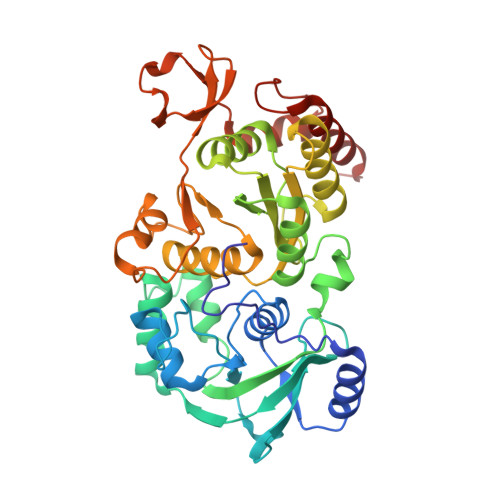Structural, biochemical and genetic characterization of dissimilatory ATP sulfurylase from Allochromatium vinosum.
Parey, K., Demmer, U., Warkentin, E., Wynen, A., Ermler, U., Dahl, C.(2013) PLoS One 8: e74707-e74707
- PubMed: 24073218
- DOI: https://doi.org/10.1371/journal.pone.0074707
- Primary Citation of Related Structures:
4DNX - PubMed Abstract:
ATP sulfurylase (ATPS) catalyzes a key reaction in the global sulfur cycle by reversibly converting inorganic sulfate (SO4 (2-)) with ATP to adenosine 5'-phosphosulfate (APS) and pyrophosphate (PPi). In this work we report on the sat encoded dissimilatory ATP sulfurylase from the sulfur-oxidizing purple sulfur bacterium Allochromatium vinosum. In this organism, the sat gene is located in one operon and co-transcribed with the aprMBA genes for membrane-bound APS reductase. Like APS reductase, Sat is dispensible for growth on reduced sulfur compounds due to the presence of an alternate, so far unidentified sulfite-oxidizing pathway in A. vinosum. Sulfate assimilation also proceeds independently of Sat by a separate pathway involving a cysDN-encoded assimilatory ATP sulfurylase. We produced the purple bacterial sat-encoded ATP sulfurylase as a recombinant protein in E. coli, determined crucial kinetic parameters and obtained a crystal structure in an open state with a ligand-free active site. By comparison with several known structures of the ATPS-APS complex in the closed state a scenario about substrate-induced conformational changes was worked out. Despite different kinetic properties ATPS involved in sulfur-oxidizing and sulfate-reducing processes are not distinguishable on a structural level presumably due to the interference between functional and evolutionary processes.
- Max-Planck-Institut für Biophysik, Frankfurt, Germany ; Institut für Biophysik und Physikalische Biochemie, Universität Regensburg, Regensburg, Germany.
Organizational Affiliation:

















